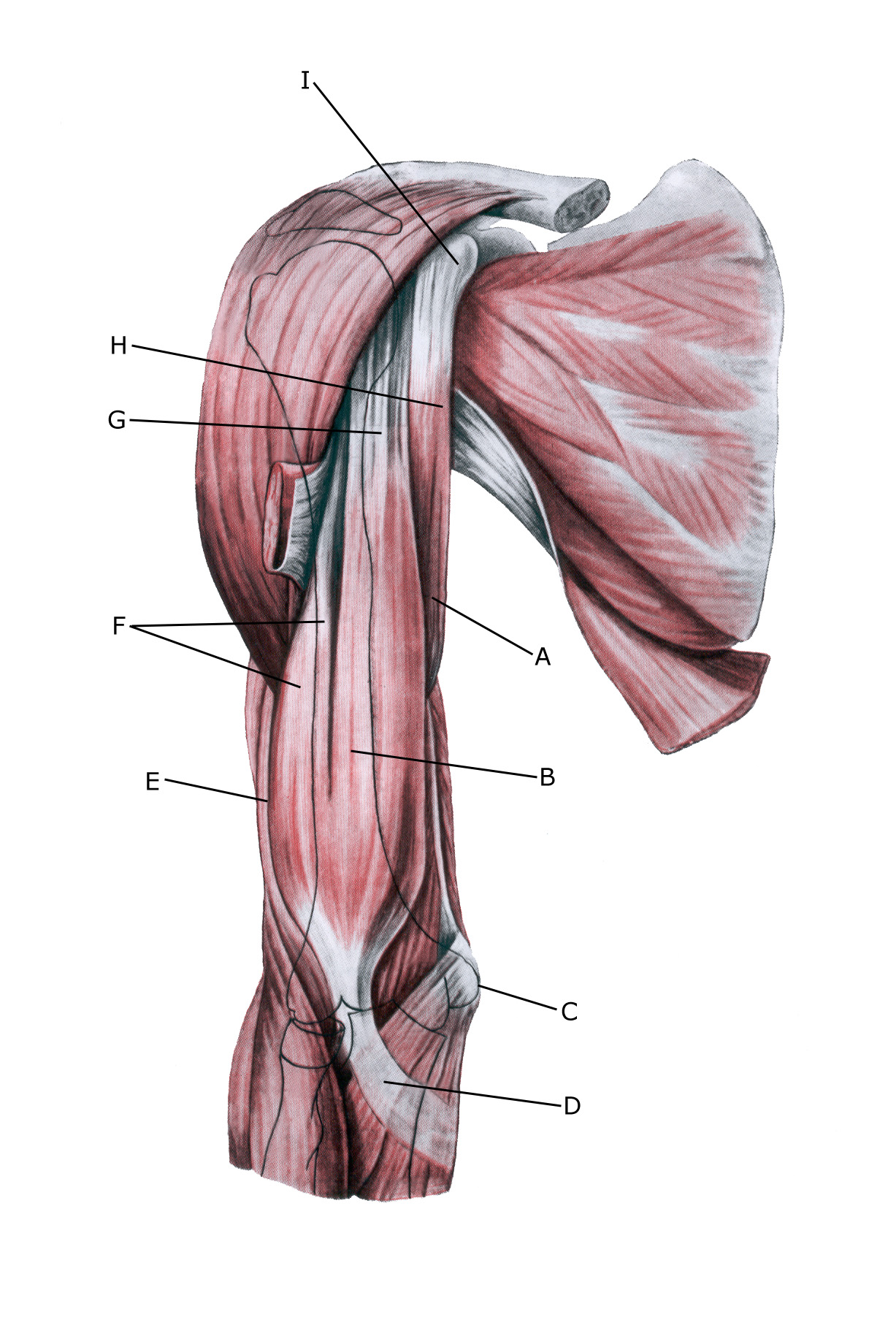Anatomy
 The upper arm muscle (M biceps brachii) has 2 tendons that attach to the shoulder blade. One tendon (caput longum) passes through the shoulder joint. The two tendons unite to form the muscle on the upper arm and attach to the forearm bones just below the elbow joint. The function of the biceps muscle is to bend the elbow and externally rotate (suppinate) the forearm. A wrap from the shoulder joint goes down around the upper part of the biceps tendon. This means that the fluid around the biceps tendon communicates with the shoulder joint.
The upper arm muscle (M biceps brachii) has 2 tendons that attach to the shoulder blade. One tendon (caput longum) passes through the shoulder joint. The two tendons unite to form the muscle on the upper arm and attach to the forearm bones just below the elbow joint. The function of the biceps muscle is to bend the elbow and externally rotate (suppinate) the forearm. A wrap from the shoulder joint goes down around the upper part of the biceps tendon. This means that the fluid around the biceps tendon communicates with the shoulder joint.
Shoulder and upper arms muscles from behind:
A. Sulcus bicipitalis medialis
B. M. biceps brachii
C. Epicondylus medialis
D. Aponeurosis m. bicipitis brachii
E. Sulcus bicipitalis lateralis
F. Caput longum (m. bicipitis brachii)
G. Caput breve (m. bicipitis brachii)
H. M. coracobrachialis
I. Processus coracoideus
Cause
With repeated (over)exertion (swimming, throwing), the long head of the upper (proximal) part of the biceps muscle (caput longum biceps brachii) becomes (inflamed). Inflammation of the biceps tendon is also called ‘swimmer’s shoulder’.
With age and repetitive strain, wear and tear changes occur in the tendon, increasing the risk of rupture. Ruptures most often occur when the muscle contracts while being stretched (eccentric contraction).
Long-term inflammation of the tendon (tendinitis) increases the risk of rupture. It is very rare for healthy tendons to rupture.
Symptoms
Slow onset of localised soreness in the front of the shoulder. Occasionally radiating to the upper arm. The pain is aggravated when the biceps tendon at the front of the shoulder is pressed when the muscle is activated (trying to bend the arm against resistance.
In a total rupture of the biceps tendon (caput longum) caused by a sudden impact, the torn biceps muscle is pulled towards the elbow, causing a bulge on the biceps muscle (‘Popeye arm’).
Examination
The diagnosis is usually made on general clinical examination, where there is pain and reduced strength when the elbow is bent against resistance or when the hand is rotated so that the palm faces up (supination). For more severe, sudden onset pain, an examination by a professional should be performed and supplemented with an ultrasound scan (possibly an MRI scan) (McKean D, Teh J. 2022) and (Courage O, et al. 2023).
See ultrasound scan of the shoulder with thickening of the biceps tendon.
Treatment
Treatment consists of relief and slow rehabilitation of the biceps muscles and the other muscles around the shoulder. Total tears of the biceps muscle rarely require surgical treatment, as the vast majority of tears can be treated with rehabilitation alone (Sudah SY, et al. 2023).
Surgery can be considered for very high demands on elbow strength (hard physical labour, body building) or for cosmetic reasons, which should be performed within the first month. If there is no progress in relieving the tendonitis, medical treatment can be considered in the form of arthritis pills, NSAID injection of adrenal cortex hormone in the wrapping fold around the thickened tendon, which can be ultrasound-guided.
As adrenal cortex hormone injection is part of a longer-term rehabilitation of a long-term injury, it is often necessary to extend the rehabilitation programme over several months to reduce the risk of recurrence and rupture. Of course, after a long-term injury, the tendon cannot withstand maximum strain after only a short-term rehabilitation period.
Complications
If the progress is not smooth, you should consider whether the diagnosis is correct or if there are complications.
In particular, the following should be considered:
- Total rupture of the biceps tendon
- Rupture of the upper shoulder blade muscle
- Inflammation of the tendon sheath of the upper shoulder blade muscle
- Inflammation of the bursa at the elbow
- Luxation of the shoulder joint
- Luxation of the joint between the shoulder blade and the collarbone
- Frozen shoulder
- Muscle infiltrations
- Meniscus lesion in the shoulder
- Nerve entrapment on the back of the shoulder blade
- As well as disorders inside the shoulder (the fluid around the biceps tendon can originate from the shoulder joint).
